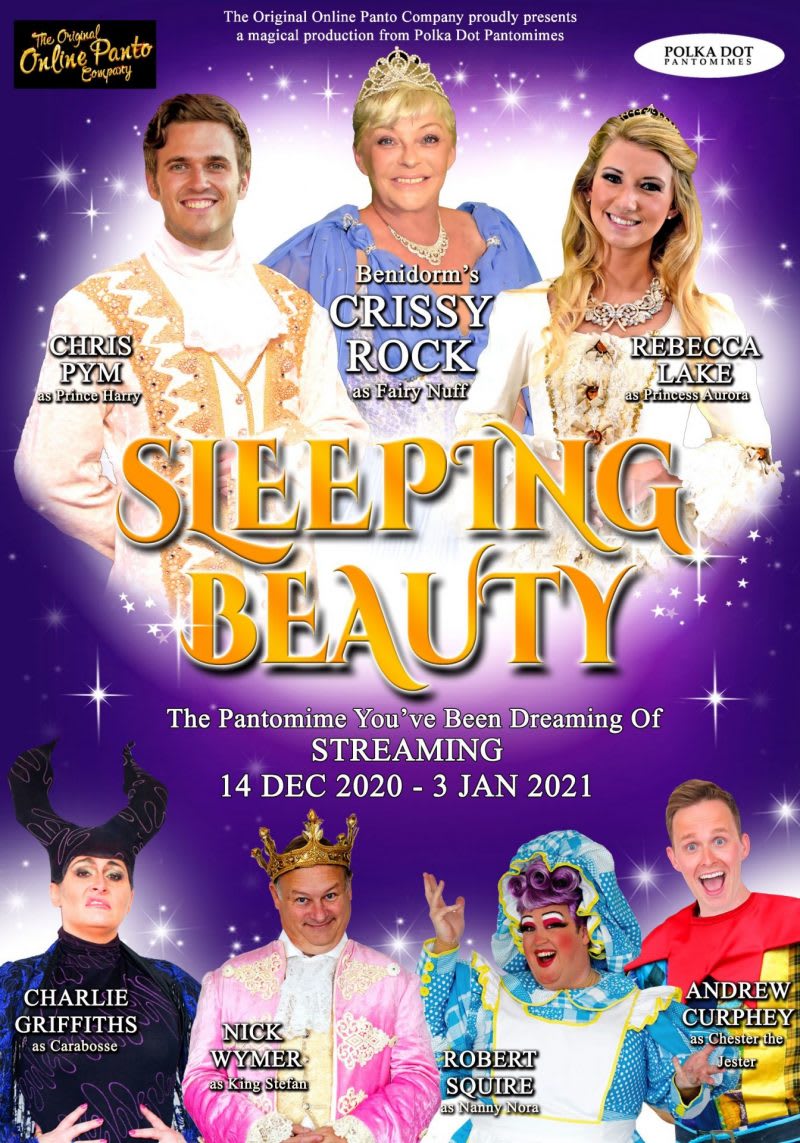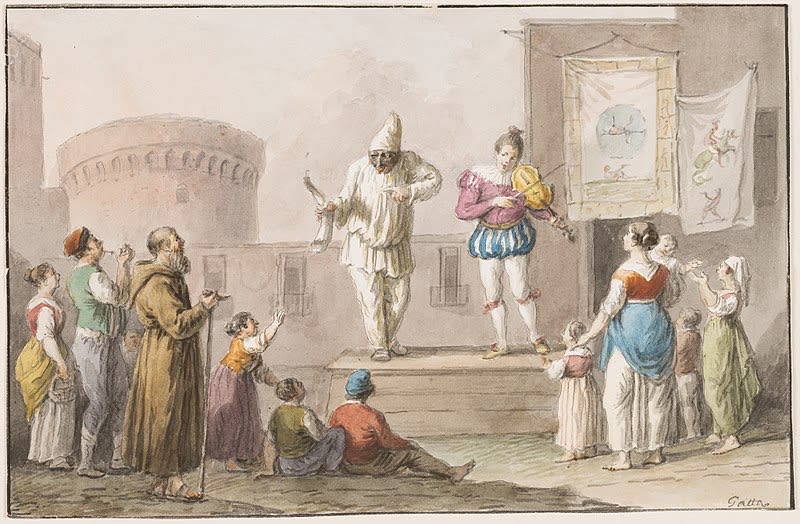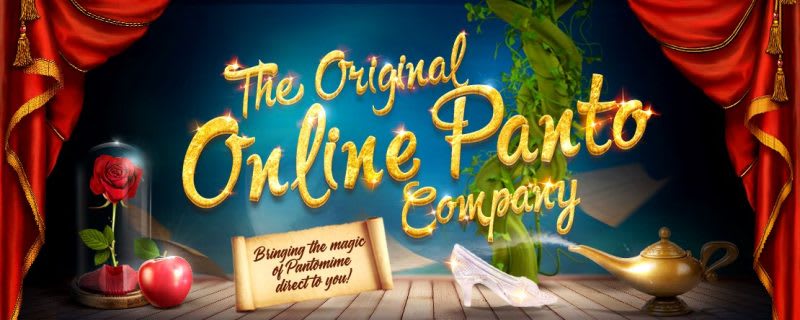The History (and Future) of Pantomime

Pantomime is such a traditional part of British Christmas that for many children it is their very first experience of live theatre. These vibrant, colourful and noisy shows have been entertaining festive audiences for centuries but this year the COVID-19 pandemic has forced the majority of the UK’s theatres to close their doors.
Many regional theatres are reliant on the annual success of their pantomimes; they employ thousands of performers, stage managers, electricians, carpenters, designers, wardrobe staff, box office staff, marketing teams and front of house staff. To hear them fall silent when they should be filled with laughter and the cries of ‘It’s behind you!’ and ‘Oh, no it isn’t!’ is heart-breaking.
However, this year the joy of pantomime can still be enjoyed by the whole family at home. You can stream The Original Online Panto Company and Polka Dot Pantomimes’ production of Sleeping Beauty between 14 December and 3 January. It is a great way for all generations to share the pantomime experience and, not only will it make a wonderful Christmas gift, but £4 from the sale of every ticket bought through the link below will go to Great Ormond Street Hospital. You can find out more about buying tickets here.



But how did pantomime become such a celebrated annual experience?
Ancient Rome – The word pantomime comes from the Latin pantomimus and it was the name for a solo dancer who performed all the parts of a story through movement and gestures.
Lots of different forms of theatre can be said to have influenced the earliest pantomimes such as the medieval Mummers’ plays and the masques of the Royal courts, but it was in the sixteenth century that we can see the beginnings of the fun and energetic shows that we would recognise today.
1550s – A form of outdoor comedic theatre known as Commedia dell’arte became popular in Italy. The actors wore masks to represent popular characters such as the old man Pantalone, the clown Pierrot, the girl Colombina and the servant Arlecchino.

Late 1600s – The Commedia dell’arte troupes toured Europe and made their way to England.
Early 1700s – English theatres began to produce their own versions of these shows and adapted the characters to fit, for example Arlecchino became known as Harlequin and he featured in a type of show filled with comedy, music and dance which was known as the Harlequinade.
1717 – Theatre manager and director John Rich combined the Harlequinade with classical theatre and created shows that were filled with spectacular sights, magic tricks, transformations, incredible acrobatics, and mime.


Mid-1700s – David Garrick, the actor-manager of The Theatre Royal, Drury Lane, was critical of these new shows but he saw that they were very popular with his audiences. He began to limit pantomimes at Drury Lane to the period over Christmas. This meant that he could stage more traditional plays such as those by William Shakespeare for the rest of the year.
Late 1700s – Pantomimes had grown in popularity and now became full of fairy tales, folk tales and nursery rhymes. Aladdin was first performed at the Theatre Royal, Covent Garden in 1788.
Around the same time, the clown Joseph Grimaldi became the star of London pantomimes. He used slapstick, audience participation, and topical satire in his performances, all things that we would recognise in a panto today.


1806 – The first pantomime version of Sleeping Beauty was performed at The Theatre Royal, Drury Lane in 1806.
1843 – Since 1660 only a few theatres which had been granted royal patents were allowed to perform plays that used spoken words. The law now changed and theatres all over the country could produce their own pantomimes which told fantastical stories and fairy tales.
1860s – Music Hall was a form of variety entertainment which grew in popularity through the nineteenth century. This combination of songs, dance, acrobatics and comedy was embraced by pantomime and many of its stars were cast as the leads in these festive shows.
1886 – Although cross dressing had been a common feature of the early pantos, Dan Leno popularised the pantomime dame.


1914 – The London Palladium staged its first pantomime; Dick Whittington and his Cat.
1939 – The very last Harlequinade was performed at the Lyceum Theatre in London.
1960s – Variety performers such as Norman Wisdom began to share the panto stage with pop stars including Cliff Richard and Cilla Black.
1990s to present day – Australian soap stars became popular pantomime performers all over the UK. Guy Pearce performed in Cinderella at the Oxford Apollo in 1991…I wonder what happened to him.


2019 – Pantomimes are now so popular that they generate more than £60 million in revenue every year. They are a huge part of the British economy and they support many regional theatres throughout the rest of the year.
2020 – The COVID-19 pandemic has forced the majority of British theatres to close their doors and pantos have been cancelled. Wait a minute…OH, NO THEY HAVEN’T! Pantomimes have moved online and are ready for audiences to laugh, shout and sing-along from the comfort of their own homes.

About Sleeping Beauty
Filmed live at the Brindley Theatre in Cheshire, Sleeping Beauty features Benidorm star Chrissy Rock and a host of musical theatre performers. It has been digitally remastered for digital audiences by The Original Online Panto Company and is available to watch between 14 December and 3 January. Your ticket costs just £15.49 (with the option to make an additional donation to The Actor’s Benevolent Fund and The Equity Benevolent Fund) and your link will be available for four days from your first viewing.
This beautiful and festive production is suitable for the whole family and you can buy your ticket here.
Disclaimer: I am not affiliated with any of the companies listed in this blog and make no profit from supporting their work. However, I think that what they are doing is wonderful and a brilliant way to raise money for Great Ormond Street Hospital.